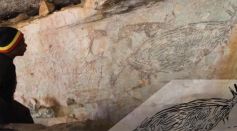ENVIRONMENT & CLIMATE
Single-Cell Slime Mold Can Remember Food Locations, Puzzling Scientists

Freshwater Fish Feared Extinct: Here's How to Safeguard Its Population
Do Houseplants Really Clean the Air Indoors?
28 Trapped Whales in New Zealand, Refloated in An Attempt to Rescue Them

Leaving Trees Where They Stand Considered Most Effective Way in Mitigating Climate Change
Oklahoma Puppy With Six Legs and Two Tails Suffer a Combination of Congenital Disorder
Bizarre Yellow Penguin Found on South Georgia Stuns Biologists

Australia's Oldest Rock Painting of Kangaroo Found To Be 17,000-Year-Old Thru Radiocarbon Dating

Pollution Allegedly Cause Reduced Sunlight Brightness: What is Global Dimming?

Home Gardens Considered Powerhouse for Pollinating Insects
Sheepshead Fish With Human-Like Teeth Is Real! Omnivore Eats 100 Various Species
Deer From Tennessee Has Hairy Eyeballs Due to Bizarre Condition, Can Humans Get Dermoids Too?

Cold Desert Nights: Why It Gets Much Colder Than People Think?

Marmots Use Own Language to Communicate With Their Tribe
Most Popular

Will Earth's Magnetic Poles Flip Next? Magnetic Pole Reversal Explained Through Cutting‑Edge Magnetosphere Science

Relativity Time Dilation Explained: The Physics of Time and Why It Moves Differently in Space

How Lightning Science Reveals Why Charged Storms Are Rising with Global Warming Effects

How AI Is Used in Weather Prediction: Smarter Forecasting Through Machine Learning





